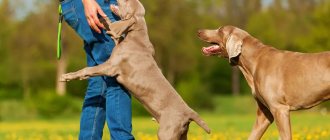I am often asked the question: how to teach a dog not to trust strangers.
Often owners are concerned that the dog is very friendly and, when it sees a person (adult or child), immediately runs to “get to know” him. It would seem - what's wrong with this? The dog is not aggressive and “loves” people. But not everything is as simple as it seems at first glance. Therefore, I propose to consider this issue more carefully.
Good dogs
So you have a sociable and “kind” dog and you let it run around without a leash. What can happen?
Jagdterrier West on the first day of training
- Many people, both adults and children, do not like dogs (why should they love them?);
I have met people who loved to look at dogs, but did not even think about going up and petting the dog. For example, my fellow student Abdumalik Sherov (from Tajikistan) was so afraid of dogs that he literally lost consciousness when some mongrel ran up to him. It was impossible to teach him not to be afraid of dogs.
- Many people, both adults and children, are afraid of dogs because they have been scared (and/or bitten) by dogs;
Not long ago, I was invited to a children's summer camp, where I was supposed to give a lecture on the LIROS dog training method and show a dog trained using this method. Before the lecture began, I asked those who had been bitten by a dog to raise their hands and was unpleasantly surprised by the “forest” of raised hands.
By the way, my wife also “doesn’t like” dogs for the same reason - when she was a child, she was scared by a dog.
- A dog that “loves” all people can easily run away, get lost, or even be stolen;
Well, this thesis does not require any comments - eloquent notices about missing pets appear on poles in every locality with enviable regularity.
- A “social” dog can be poisoned;
So far this is just my guess, but given how many “dog hunters” have appeared recently, it is quite likely.
- If you assign protective or security functions to your “kind” dog, then, of course, it will not cope with them;
I have had to deal with this situation more than once. For example, in the village of Skhodnya (Moscow region), a man was stabbed 15 times at the gate of his house, while his “guard” East European Shepherd was sleeping peacefully on the other side of the fence!
Thus, every sociable (kind) dog running without a leash is a potential source of social conflicts. And it is the responsibility of every owner of such a dog, at a minimum, to keep it on a leash, and at most to train it not to react to strangers.
Psychological conflict
A person sometimes forgets that a dog thinks differently from him. She sits at home all day, eagerly waiting for her beloved owner. And if he appears on the doorstep of the apartment at approximately the same time, biochemical processes begin in the dog’s body, as a result of which hormones responsible for the feeling of delight and happiness are released.
The dog sits at home all day, eagerly waiting for his beloved owner
This theory was developed by a Polish psychologist who experimented with experimental dogs. The scientist served food to the animals' bowls once every 10 minutes, turning on a bright light before doing so. It was possible to reveal that after some time, salivation in dogs begins to intensify before food is served, even without flashes of light. The psychologist said that a constant reaction to pleasant stimuli causes the animals' bodies to hallucinate.
And at the moment when the dog is morally and biochemically determined to meet its owner, instead of the long-awaited pleasant communication, it receives a scream, a blow or a slap. This causes an internal psychological conflict: the dog is simply not able to understand why the owner behaves this way. You can extinguish this nuisance with affection after the animal has performed the action correctly.
A beloved owner awakens the same happiness hormones in a dog’s body as a bowl of delicious food
Aggressive dogs
We have dealt with the “good” dogs. Now let's figure out what to do if you have an aggressive dog on the contrary, barking and barking at passers-by. Where does she get such aggression towards people?
In this case, there can be only two options:
- Your dog is a dominant type and has taken on the role of your protector;
- Your dog is a cowardly psychotype and barks at people because he is afraid of them.
In both cases, you need to take control of the dog's aggressive behavior. Aggression is not a “tooth spoiled by caries” - it cannot simply be taken and pulled out. There can only be one way out - to teach the dog to use aggression exclusively when attacking you or trying to steal your property. And in the case of aggression from a cowardly dog, it is also necessary to teach the dog not to be afraid of strangers.
Unconventional measures to correct the behavior of a four-legged animal
For choleric animals, weaning from jumping on the owner may last indefinitely or even require the most drastic measures. Experts recommend using a more tangible negative impact on overly active dogs: ringing spanks, pushing away or strict parforce.
Basic rules for using a collar
Despite all the efforts made, it is very difficult for a dog to cope with excess emotions towards the owner, since the release of hormones is to blame for everything. One of the doctors from the American Veterinary Association found a way out. He suggested that owners of dogs with a choleric type of character give their pets drugs that can calm them down. This:
- silicea (a single dose once a day during periods of noticeable emotional agitation);
Silicea
- brewed St. John's wort, 1 tbsp. powder per glass of boiling water (from 3 to 8 mg twice a day, give for about a week);
Brewed St. John's wort
- phosphorus C 30 (1 dose is given daily, duration of administration is a week);
Phosphorus C 30
- yeast (half a small spoon for an animal up to 14 kg, a whole spoon for an animal up to 50 kg); Consultation with a veterinarian is required as they may cause allergies.
Yeast
Important! Medicines can only be purchased at a pharmacy and only on the recommendation of a specialist.
Teaching your dog to be neutral towards strangers
On the other hand, by teaching your dog a neutral attitude towards strangers, you will immediately solve all the problems listed above.
Your dog:
- Will cease to be interested in strangers, regardless of their age; she will never run to them to “get acquainted”;
- Stops a criminal who decides to attack you;
- Protects your belongings;
- Will protect the territory of your estate from unauthorized people entering it;
- Will never get lost;
- Will not take food from strangers.
The sequence of teaching a dog to distrust strangers
We train all dogs to distrust strangers in stages according to the following scheme:
- Stage one - we train the dog according to the LIROS course (leadership-role training of the dog) in order to create a working team (surrogate pack), social ranks and social relationships (senior-junior);
As a result of such training, the dog becomes obedient, since it is subordinate, the fulfillment of its desires is placed under stimulus control (controlled by the owner’s signals), the basis for conflicts is eliminated and the owner (his behavior, requirements) becomes clear to the dog and it is maximally ready for further training.
- Additionally, the dog is protected from communicating with strangers - none of your friends or acquaintances are allowed to pet the dog (“get your own and pet it for good health”), since your dog has no “friends”;
The dog is accustomed to being in a cage at home and in an enclosure in the yard. She doesn't feel stressed when she's there. And when friends or acquaintances come to visit, the dog goes to its place to rest (in a cage or enclosure).
- Stage two - we train the dog to protect our “resources”: food, territory, household items, and also ensure the personal safety of the owner;
- Additionally, we train the dog not to react to strangers if they do not “encroach” on the resources of our “pack” (do not show aggression towards us, do not attack, do not try to steal our things).
Now you understand that instead of the question - “How to wean a dog to trust strangers?” The following question should be asked: “How to teach a dog not to trust strangers?” And we can give a specific answer to this in a video of a specially designed training program.
Jagdterrier West during training to protect the handler and backpack
Classic parenting methods
Raising a puppy has its own nuances, just like retraining an adult dog. The same rules apply to jumping on the owner. If such behavior in a child only causes tenderness, and can be stopped with a slight wave of the hand, then a large adult dog rushing at a person is already frightening.
A large dog jumps on its owner
So, classical weaning methods can be divided depending on the age of the four-legged pet.
Weaning a puppy from jumping using gentle methods
Tiny puppies should be restrained when they try to jump on people. It happens like this:
- The owner comes home from work, immediately puts the bags on the floor and goes down to the dog. Desires to jump are stopped by the command “no” and persistent pressing of the dog to the floor.
- When the puppy realizes that jumping is prohibited and puts his paws on the floor, you need to hold out your hand and let him lick it. This way the puppy will say hello to the owner and show his devotion and love. However, any attempt to jump must be persistently but gently stopped at the very beginning.
- You can pet a sitting puppy, praise it, and give it a treat. After the baby calms down, his owner can get up and go about his business - take things to the room, unpack bags.
- If the baby comes up to the owner, rests his paws on his leg and asks to be held, you should never pick him up and hold him close to you. This can only be done after the puppy has completely calmed down and stopped jumping.
All family members should take part in training the puppy. If adults try to wean the baby from the habit, and children joyfully rush into the arms of a puppy when they come back from a walk, the exercises will never bring the desired result. As the puppy grows up, measures to wean him from jumping become more and more stringent, so it is better to completely complete the process while still a puppy.
Important! You should never punish or beat your baby, otherwise he will turn into a constantly peeing and shaking ball of fur. There will be no talk of any joy at the sight of the owner. In addition, animals lack logical thinking, so the dog will not understand why it was punished, and mutual understanding with the owner will be completely lost.
A small dog should always be rewarded when it does something right.
Weaning an adult dog
Training obedience in an adult dog is more difficult. In the classic version of the jumping weaning course, experts identify several methods, which are presented in the table below.
Table 1. Traditional ways to stop an adult dog from jumping on its owner.
| Way | Description |
| Loss of eye contact | When the dog approaches the owner, he should turn his back or side to it. This way, eye contact with the pet will be lost, he will not see the person’s reaction to his actions and will hesitate. |
| Adding ban commands | The previous method can be made more effective by adding to the lack of reaction the commands “no” or “fu”, said clearly, in a stern tone. |
| Hold | An animal that has already jumped to its owner, but has not yet placed its paws on his chest, can be grabbed by the front limbs. The dog will be unpleasant for such a gesture, after which it will rush to return its paws to the ground. |
| Prohibiting gestures | Dogs don't like having something constantly moving in front of their nose. This can be used for your own purposes. For example, when a dog starts jumping on its owner, you should take a step back, extend your hand in front of you and wave it in front of the pet’s nose. It is best to accompany this gesture with the order “no”. |
If one of the methods worked, and the dog still stopped trying to greet his friend, you can pet him, feed him a treat and praise him. This way the animal will understand that the owner is not angry and is pleased with the long-awaited calm behavior of the dog. It is important to teach your dog basic commands in advance, such as “fu”, “no”, “sit” and others. They will help stop excessive joy from meeting the owner.
German Shepherd learns the “down” command
It is important to remember that:
- the prohibition command must be pronounced before a negative impact - holding, pushing, splashing water;
- the animal must certainly be praised after it rests its paws on the floor so that good behavior is instilled more effectively;
- all family members must be on the same page and use the same methods of prohibition;
- no one is allowed to scream or hit the dog, even if he tore a grocery bag or expensive tights in a jump.
History of the Jagd Terrier Vesta
Recently our Jagd Terrier West underwent such training.
On the last hunt, he was almost taken away by unknown hunters, and only thanks to a happy accident did he return to his owner.
As you can see, something similar can happen even to such dominant and aggressive dogs as Jagdterriers.
It took us twelve days to complete basic training in all of the above.
While training the dog, we were not lazy and filmed the entire training process.
And now that we have completed West’s training, I began to prepare and package these videos into a training video course.
Very soon it will be available on our website for all dog owners.
A preliminary application for its purchase can be made by sending a letter to our e-mail, or by calling us by phone (see information on the “Contacts” page
You can sign up for individual training on the LIROS course here.
My friend, Vitaly Vitalievich kindly agreed to help in training the Jagd Terrier West
Share on social media networks
RќСЂР°РІРёС‚СЃСЏ
How to catch a fugitive
If your dog runs away, there are several ways to catch the fugitive.
Play hide and seek with your pet
If the dog runs away from you, it is necessary to form a new behavior pattern in which the dog will be forced to constantly monitor you. There is a very effective way to prevent escapes and it is called “Hide and Seek”.
While walking with your pet, hide behind a tree or bush. At the same time, always keep the tail in sight. Next, say his name out loud.
The baby will definitely start looking for you, and when he finds you, he will be very happy. When leaving the shelter, rejoice wildly with the dog, praise it, and treat it with a treat.
I started playing a similar game with Jackusik at home, when he couldn’t walk outside due to the lack of all the necessary vaccinations.
In case of escape, be unpredictable
If a dog runs away from you, do something unpredictable, because a dog that is carried away by something may not hear its owner’s calls to return.
Throw a plastic bottle, leash or glove towards a walking four-legged animal, clap your hands, jump or sit up sharply. You can even lie down on the ground and start howling. Well, let passers-by think that you are a client of the “Kanatchikova Dacha” (as in V. Vysotsky’s song), but such strange behavior will definitely attract the attention of the “fugitive”.
Make your client feel jealous
Alternatively, you can try demonstratively petting and praising someone else’s dog, saying: “What a good boy!” All four-legged animals have a very well developed sense of jealousy. Therefore, most likely, your lack of hearing will immediately come running and, having driven away the opponent, he himself will begin to fawn on you.











